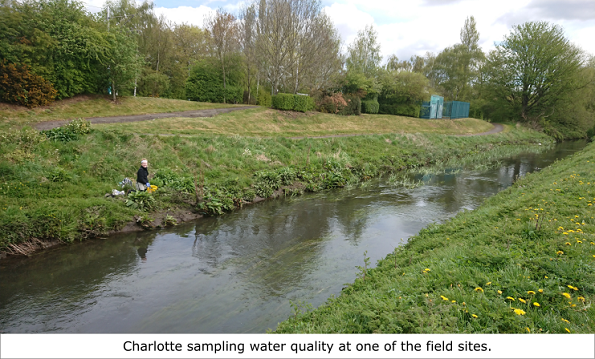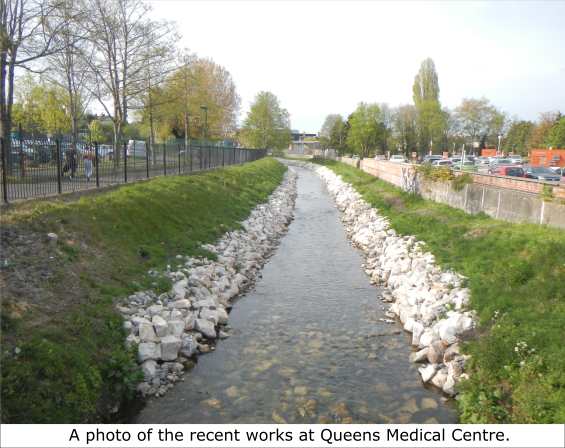
June 24, 2021, by Blue-Green team
Investigating the water quality of the River Leen
Hazel Wilson and Charlotte Viner (University of Nottingham) have recently been out and about doing fieldwork in the River Leen. They’ve been investigating the water quality, invertebrates, and habitat quality of the river as it flows through the city of Nottingham.
Background information
Urban rivers like the River Leen have been heavily impacted by humans to make space for development and to manage flood risk. They have often been straightened and cleared of habitat and vegetation, and many have problems with water quality. However, things have been improving in the last few decades as we’ve come to recognise the value of biodiversity and blue-green spaces.
In order to keep improving rivers we need to understand the current condition of the river, so we wanted to investigate the water and habitat quality by doing some fieldwork.
We had ten survey sites along the Leen (Figure 1). These sites were chosen to correspond to Environment Agency (EA) sites, so we can compare to their regular monitoring (they’ve kindly provided us with data since 2013), but we had additional sites to fill in the gaps.

Figure 1 : Sites monitored on the River Leen for this study. The red lines delineate the two Water
Framework Directive (WFD) (2000/60/EC) catchment areas used to classify the ecological status of the river: the upper catchment from source to Day Brook, and the lower catchment from Day Brook to the River Trent. Data from EA (2021b) and OS Open Rivers (2021).
Main research findings
Water quality and invertebrate communities in the River Leen
We found that water quality and invertebrate communities in the River Leen are generally good. Our data was broadly similar to what the EA have found, showing that water quality in particular has been improving in recent years. Figure 2 shows how soluble reactive phosphorus (SRP) concentrations have improved over time. High concentrations of this nutrient can lead to accelerated growth of algae and plants which can, in turn, impact oxygen levels and river habitat characteristics, leading to significantly altered community structures. However, SRP concentrations along the River Leen were low, indicating good or high status in recent years.

Figure 2. Soluble reactive phosphorus (SRP) concentrations for four sites on the River Leen for sample years 2013 to 2021. 2013-2017 data collected by the EA (2021a) and 2021 data collected during this study. The approximate threshold values between moderate and good, and good and high WFD classification standards are indicated by the black dotted lines.
Nutrient concentrations
We found that nutrient concentrations were greater downstream of the tributary with Day Brook. Preventing pollution by industry, wastewater treatment, and household misconnections could help improve matters for the Leen and Day Brook.
Habitat quality
We found that habitat quality decreased downstream in the catchment, which corresponded with an increase in modification of the river. There is a possibility of future river restoration to improve this, for example there have recently been works at Queens Medical Centre to stabilise flood defences and provide fish habitat.
Isolated pollution events
On some days and at some sites, we found higher pollution levels than was found at other sites/times. Regular longer-term monitoring at more sites could help us better understand whether isolated pollution events are occurring and how best to prevent them. For instance, after a period of heavy rainfall, we found higher (although not dangerous) levels of ammonia at our Mill Street Playing Fields sampling site.
Summary
Taken together, these results are good news as they show that conditions in the River Leen are fairly good considering the level of urbanisation of the catchment, and the improving conditions over time are promising for the future health of the river. We really enjoyed getting out and about on fieldwork and getting to know the River Leen a bit better!
The full report can be found at http://www.urbanfloodresilience.ac.uk/documents/the-health-of-the-river-leen.pdf.
No comments yet, fill out a comment to be the first



Leave a Reply